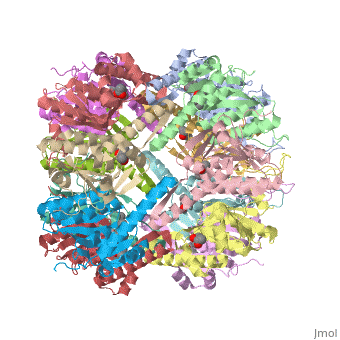Molecular Playground/E. coli ClpP
From Proteopedia
(Difference between revisions)
| Line 10: | Line 10: | ||
Featured within the core of ClpP are the catalytic sets of amino acids [X-Y-Z] that constitute the active mechanism featured by serene proteases [http://www.ncbi.nlm.nih.gov/pubmed/2197276][http://www.ncbi.nlm.nih.gov/pubmed/17499722]. Human ClpP can exist in two forms, a single heptameric ring or as a double stack set of hepatmeric rings where the double stacked form (tetradecamer) is the active form [http://www.ncbi.nlm.nih.gov/pubmed/16115876]. Tetradecamer ClpP is a stable but not a rigid structure that can undergo several conformational forms when interacting with its regulatory elements. By doing so both stabilizes processivity of translocation by the regulatory elements and is thought to increase likelihood of exposure to the active sites resulting in timely, small peptide formation. | Featured within the core of ClpP are the catalytic sets of amino acids [X-Y-Z] that constitute the active mechanism featured by serene proteases [http://www.ncbi.nlm.nih.gov/pubmed/2197276][http://www.ncbi.nlm.nih.gov/pubmed/17499722]. Human ClpP can exist in two forms, a single heptameric ring or as a double stack set of hepatmeric rings where the double stacked form (tetradecamer) is the active form [http://www.ncbi.nlm.nih.gov/pubmed/16115876]. Tetradecamer ClpP is a stable but not a rigid structure that can undergo several conformational forms when interacting with its regulatory elements. By doing so both stabilizes processivity of translocation by the regulatory elements and is thought to increase likelihood of exposure to the active sites resulting in timely, small peptide formation. | ||
| - | This is a sample scene created with SAT to <scene name="/12/3456/Sample/1">color</scene> by Group, and another to make <scene name="/12/3456/Sample/2">a transparent representation</scene> of the protein. You can make your own scenes on SAT starting from scratch or loading and editing one of these sample scenes. | ||
== Role of ClpP/Biological Relevance == | == Role of ClpP/Biological Relevance == | ||
''E. coli'' ClpAP/ClpXP complexes play a critical role in maintaining protein homeostasis under several levels of quality control. Improperly folded or aggregated proteins are potential ClpP substrates based on properties of the associated regulatory element recognition. Targeted removal of aberrant proteins resulting from and rescue of stalled ribosomes by the SsrA tagging system are directly recognized and degraded by ClpAP/ClpXP complexes [http://www.ncbi.nlm.nih.gov/pubmed/9573050]. In ''E. coli'' ClpP and ClpP homologues found in other bacteria require regulatory elements to recognize and import proteins for destruction. To gain access to the active sites is tightly controlled and therefore a potential antimicrobial target where loss of regulation (for example, through use of acyldepsipeptides or ADEPs) literally digests the bacteria from the inside out [http://link.springer.com/chapter/10.1007/978-94-007-6787-4_24]. ''E. coli'' ClpAP and ClpXP has been used as a structural model for the 26 proteasome to gain insight into its workings [http://www.ncbi.nlm.nih.gov/pubmed/7623377][http://www.ncbi.nlm.nih.gov/pubmed/14990998]. | ''E. coli'' ClpAP/ClpXP complexes play a critical role in maintaining protein homeostasis under several levels of quality control. Improperly folded or aggregated proteins are potential ClpP substrates based on properties of the associated regulatory element recognition. Targeted removal of aberrant proteins resulting from and rescue of stalled ribosomes by the SsrA tagging system are directly recognized and degraded by ClpAP/ClpXP complexes [http://www.ncbi.nlm.nih.gov/pubmed/9573050]. In ''E. coli'' ClpP and ClpP homologues found in other bacteria require regulatory elements to recognize and import proteins for destruction. To gain access to the active sites is tightly controlled and therefore a potential antimicrobial target where loss of regulation (for example, through use of acyldepsipeptides or ADEPs) literally digests the bacteria from the inside out [http://link.springer.com/chapter/10.1007/978-94-007-6787-4_24]. ''E. coli'' ClpAP and ClpXP has been used as a structural model for the 26 proteasome to gain insight into its workings [http://www.ncbi.nlm.nih.gov/pubmed/7623377][http://www.ncbi.nlm.nih.gov/pubmed/14990998]. | ||
Revision as of 22:03, 3 December 2014
Here in the Chien lab, we study how proteolysis plays a large part in protein quality control. The maintenance and timely destruction of protein levels plays an important role during cell homeostasis and cell transitions/differentiation, yet much of what governs these processes has yet to be fully understood.
| |||||||||||
References
6. Clp P represents a unique family of serine proteases. Maurizi MR et. al (1990 J Biolchem)
Acknowledgements
Kamal Joshi, Joanne Lau, Jing Liu, Rob Vass

